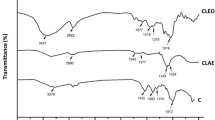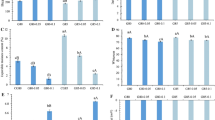Abstract
The effect of Kappaphycopsis cottonii powder/konjac composite as a natural thickener in fish balls formulation was investigated. A series of combinations of K. cottonii powder/konjac with the ratio of 5:0, 4:1, 3:2, 2:3, and 1:4 (w/w) was used. The K. cottonii powder/konjac combinations were analysed for their gel strength, elasticity, whiteness, and gelatinisation profile using a Rapid Visco Analyzer. The best combination of the composite powder was further used in the formulations of tuna fish balls at levels of 0, 0.5, 1, 1.5, 2, and 2.5% (w/w). The fish balls were characterized for their chemical properties (moisture, ash, protein, fat content), texture profile (hardness, adhesiveness, springiness, gumminess, chewiness), colour, and sensory attributes. The results showed that the K. cottonii powder/konjac (4:1 w/w) produced the gel with the highest elasticity and whiteness, thus it is preferred to use in the fish balls formulation. The incorporation of composite powder into tuna fish balls formulation produced a significant effect on the color of the fish balls. The addition of 1% of the composite powder produced fish balls with high springiness and chewiness.



Similar content being viewed by others
Data availability
The datasets generated during and/or analysed during the current study are available from the corresponding author on reasonable request.
References
Amini Sarteshnizi R, Hosseini H, Mousavi Khaneghah A, Karimi N (2015) A review on application of hydrocolloids in meat and poultry products. Int Food Res J 22:872–887
AOAC (2005) Official Methods of Analysis of AOAC International, 18th Edition. Association of Official Analytical Chemists, Gaithersburg, USA
Ardianti Y, Widyastuti S, Rosmilawati SW, Handito D (2014) The effect of the addition of carrageenan on the physical and organoleptic properties of cob fish balls (Euthynnus affinis). Agroteknos 24:159
Arltoft D, Ipsen R, Madsen F, de Vries J (2007) Interactions between carrageenans and milk proteins: A microstructural and rheological study. Biomacromol 8:729–736
Asikin N, Andi KI, Hidayat T (2020) Characteristics of fish balls on various concentration of carrageenan from different harvest time of Kappaphycus alvarezii. Asian J Pharm Clin Res 13:63–66
Aukkanit N, Kemngoen T, Ponharn N (2015) Utilization of corn silk in low fat meatballs and its characteristics. Procedia Soc Behav Sci 197:1403–1410
Ayadi MA, Kechaou A, Makni I, Attia H (2009) Influence of carrageenan addition on Turkey meat sausages properties. J Food Eng 93(3):278–83
Basmal J, Irianto HE, Utomo BSB, Subaryono SE, Nurhayati FD, Agusman (2018) Innovation in sap extraction technology and organic powdered cottonii (OPC) processing and its utilization. RCMFPPB Press, Jakarta
Baeza RI, Carp DJ, Pérez OE, Pilosof AMR (2002) κ -Carrageenan—protein interactions: effect of proteins on polysaccharide gelling and textural properties. LWT - Food Sci Technol 35:741–747
Bartlová M, Tremlová B, Marcinčák S, Pospiech M (2021) Detection of carrageenan in meat products using lectin histochemistry. Foods 10:764
Blakemore WR (2016) Polysaccharide ingredients: Carrageenan. Ref Module Food Sci. https://doi.org/10.1016/B978-0-08-100596-5.03251-0
BSN (2017) Fish ball. SNI 7266:1–12
BSN (2011) Instructions for organoleptic and/or sensory testing of fishery products. SNI 2346:18
Chávez-Sánchez T, Piñón-Gimate A, Melton III JT, López-Bautista JM, Casas-Valdez M (2019) First report, along with nomenclature adjustments, of Ulva ohnoi, U. tepida and U. torta (Ulvaceae, Ulvales, Chlorophyta) from northwestern Mexico. Bot Mar 62:113–123
Chen Y, Hong J, Jiang Z, Wu L, Wang X, Zhu Y, Jiang Z, Ni H, Zheng M (2023) Effect of red algae powder on gel properties and in vitro hypolipidemic activity of fish balls. Algal Res 74:103223
Demirci ZO, Yılmaz I, Demirci AŞ (2014) Effects of xanthan, guar, carrageenan and locust bean gum addition on physical, chemical and sensory properties of meatballs. LWT - Food Sci Technol 51:936–942
Devaraj RD, Reddy CK, Xu B (2019) Health-promoting effects of konjac glucomannan and its practical applications: A critical review. Int J Biol Macromol 126:273–281
Fan L, Ruan D, Shen HuZ, Liu C, Chen X, Xia W, Xu Y (2022) The role of water and oil migration in juiciness loss of stuffed fish ball with the fillings of pig fat/meat as affected by freeze-thaw cycles and cooking process. LWT - Food Sci Technol 159:113244
Feng X, Fu C, Yang H (2017) Gelatin addition improves the nutrient retention, texture and mass transfer of fish balls without altering their nanostructure during boiling. LWT - Food Sci Technol 77:142e151
Firdaus M (2018) The profile of tuna and cakalang fishery in Indonesia. Bul Ilmiah Marina Sosial Ekon Kelautan Dan Perikanan 4:23–32
FMC Corp (1977) Carrageenan.Marine Colloids Division. FMC Corporation, Philadelphia, USA
Guenneugues PM, Lanelli J (2013) Surimi resources and market. In: Park JW (ed) Surimi and Surimi Seafood, 3rd Edition. CRC Press, Boca Raton, pp 25–53
Hasmadi M, Noorfarahzilah M, Noraidah H, Zainol MK, Jahurul MH (2020) Functional properties of composite powder: A review. Food Res 4:1820–1831
Hikmayani Y, Apriliani T, Adi TR (2017) Alternative solutions for the sustainability of the surimi industry in Indonesia. Bul Ilmiah Marina Sosial Ekon Kelautan Dan Perikanan 3:41
Hsu SY, Chung HY (2000) Interactions of konjac, agar, curdlan gum, κ-carrageenan and reheating treatment in emulsified fish balls. J Food Eng 44:199–204
Ikhlas B, Huda N, Noryati I (2011) Chemical composition and physicochemical properties of fish balls prepared from mechanically deboned quail meat using various types of powder. Int J Poult Sci 10:30–37
Indonesian Pole Line and Handline Fisheries Association (AP2HI) (2018) Our Tuna Facts. https://indonesiantuna.com/our-tuna-facts/ accessed 20 July 2023
Kamruzzaman M, Akter F, Bhuiyan MMH, Khan MGQ, Rahman MR (2006) Consumers acceptance and market test of fish sausage and fish ball prepared from sea catfish, Tachsurus thalassinus. Pak J Biol Sci 9:1014–1020
Kelleher SD, Hultin HO, Wilhelm KA (1994) Stability of mackerel surimi prepared under lipid-stabilizing processing conditions. J Food Sci 59:269–271
Lai VMF, Wong PL, Lii CY (2000) Effects of cation properties on sol-gel transition and gel properties of κ-carrageenan. J Food Sci 65:1332–1337
Lin JH, Liang CW, Chang YH (2016) Effect of starch source on gel properties of kappa-carrageenan-starch dispersions. Food Hydrocoll 60:509–515
Lu Z, Wang L, Xie H, Lei Q, Fang W, Lu X. (2020) Structural transitions of ovalbumin/κ-carrageenan complexes under the effects of pH and composition. Chem Phys 533:110733
Meng X, Wu D, Zhang Z, Wang H, Wu P, Xu Z, Gao Z, Mintah BK, Dabbour M (2022) An overview of factors affecting the quality of beef meatballs: Processing and preservation. Food Sci Nutr 10:1961–1974
Mourente G, Tocher DR (2009) Tuna nutrition and feeds: Current status and future perspectives. Rev Fish Sci 17:373–390
Necas J, Bartosikova L (2013) Carrageenan: A review. Vet Med 58:187–205
Nugroho CH, Amalia U, Rianingsih L (2019) Physicochemical characteristics of trash fish balls with the addition of transglutaminases at different concentrations. Jurnal Ilmu Dan Teknol Perikanan 1:47–55
Nurkhoeriyati T, Huda N, Ruzita A (2010) Surimi-like material: challenges and prospects. Int Food Res J 517:509–517
Pattipeilohy F, Moniharapon A (2015) Utilizing of dark meat tuna fish (Thunnus sp.) and trash fish surimi in the processing of fish burger. KnE Life Sci 1:53–62
Penroj P, Mitchell JR, Hill SE, Ganjanagunchorn W (2005) Effect of konjac glucomannan deacetylation on the properties of gels formed from mixtures of kappa carrageenan and konjac glucomannan. Carbohydr Polym 59:367–376
Ratrinia WP, Hasibuan NE, Zein DSA (2021) Study on microbiological quality of marlin fish balls from several markets in tanggamus, Lampung. IOP Conf Ser: Earth Environ Sci 763:012053
Sarmiento K, Pereda JMR, Ventolero MF, Santos MD (2018) Not fish in fish balls: fraud in some processed seafood products detected by using DNA barcoding. Philipp Sci Lett 11:30–36
Sihono PAH, Wibowo S, Dewi FR (2021) Current (2021) status of surimi industry in Indonesia and possible solutions: a review. IOP Conf Ser: Earth Environ Sci 919:012036
Suryani A, Santoso J, Rusli MS (2015) Characteristics and microstructure of semirefined carrageenan and glucomannan mixed gels. Jurnal Kimia Dan Kemasan 37:19
Tee ET, Siow LF (2017) Effect of tapioca and potato starch on the physical properties of frozen spanish Mackerel (Scomberomoru guttatus) fish balls. Int Food Res J 24:182–190
Tunieva EK, Spiridonov KI, Nasonova VV (2021) A study on the synergetic interaction of kappa-carrageenan with konjac gum. IOP Conf Ser: Earth Environ Sci 640:052012
Wang L, Xiao M, Dai S, Song J, Ni X, Fang Y, Corke H, Jiang F (2014) Interactions between carboxymethyl konjac glucomannan and soy protein isolate in blended films. Carbohydr Polym 101:136–145
Wenno MR, Loppies CRM (2019) Physico-chemical characteristics and amino acid profile of fermented sauce made from tuna loin by-product. IOP Conf Ser: Earth Environ Sci 370:012006
Widati AS, Rosyidi D, Radiati LE, Nursyam H (2021) The effect of seaweed (Eucheuma cottonii) powder addition on physicochemical and sensory characteristics of an Indonesian-style beef fish balls. Int J Food Stud 10:112–120
Wu D, Yu S, Liang H, Eid M, Li B, Li J, Mao J (2021) An innovative konjac glucomannan/κ-carrageenan mixed tensile gel. J Sci Food Agric 101:5067–5074
Yang H, Park JW (1998) Effects of starch properties and thermal-processing conditions on surimi–starch gels. LWT-Food Sci Technol 31:344–353
Zhang F, Fang L, Wang C, Shi L, Chang T, Yang H, Cui M (2013) Effects of starches on the textural, rheological, and color properties of surimi–beef gels with microbial tranglutaminase. Meat Sci 93:533–537
Acknowledgments
The authors would like to express their sincere thanks to the Research Center for Marine and Fisheries Product Processing and Biotechnology, Ministry of Marine Affairs and Fisheries for analysis facility supports.
Funding
None.
Author information
Authors and Affiliations
Contributions
Conseptualization, Nurhayati, Agusman, and Jamal Basmal; methodology, Nurhayati and Agusman; software, Nurhayati and Agusman; formal analysis, Nurhayati and Agusman; resources, Nurhayati and Agusman; writing-original draft preparation, Nurhayati, Agusman and Diah Ikasari; writing-review and editing, Diah Ikasari, Rinta Kusumawati, and Ifah Munifah; supervision, Jamal Basmal.
Corresponding author
Ethics declarations
Competing interests
The authors declare no competing interests.
Conflicts of interests
The authors declare that they have no known competing financial interests or personal relationships that could have appeared to influence the work reported in this paper.
Additional information
Publisher's Note
Springer Nature remains neutral with regard to jurisdictional claims in published maps and institutional affiliations.
Rights and permissions
Springer Nature or its licensor (e.g. a society or other partner) holds exclusive rights to this article under a publishing agreement with the author(s) or other rightsholder(s); author self-archiving of the accepted manuscript version of this article is solely governed by the terms of such publishing agreement and applicable law.
About this article
Cite this article
Nurhayati, Agusman, Basmal, J. et al. Effect of Kappaphycopsis cottonii powder/konjac composite on the characteristics of tuna (Thunnus sp.) fish balls. J Appl Phycol 36, 421–431 (2024). https://doi.org/10.1007/s10811-023-03130-9
Received:
Revised:
Accepted:
Published:
Issue Date:
DOI: https://doi.org/10.1007/s10811-023-03130-9




